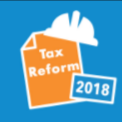Crucial Tax Reform Changes for Real Estate and Construction Companies
 The Tax Cuts and Jobs Act (TCJA) will undoubtedly have a massive impact on construction companies and real estate industry sector. The enacted TCJA is the driver for the most comprehensive alterations to American tax laws in more than three decades. The inclusion of reducing the highest corporate tax rate to 21 percent and the inclusion of providing a 20 percent taxable income deduction for designated and qualified pass-through entities are both receiving a lot of attention. These two clauses, even alone, would allow for lower taxes owed by corporations and pass-through business owners.
The Tax Cuts and Jobs Act (TCJA) will undoubtedly have a massive impact on construction companies and real estate industry sector. The enacted TCJA is the driver for the most comprehensive alterations to American tax laws in more than three decades. The inclusion of reducing the highest corporate tax rate to 21 percent and the inclusion of providing a 20 percent taxable income deduction for designated and qualified pass-through entities are both receiving a lot of attention. These two clauses, even alone, would allow for lower taxes owed by corporations and pass-through business owners.
Comprehension of the TCJA’s aforementioned new provisions coupled with hundreds of additional new provisions, prolific modifications and the repeal of now older-existing provisions, is a tall order. On top of that, the TCJA is loaded with countless phaseout and effective dates. The intent of this post is to identify the most impactful tax law changes regarding the construction and real estate industries for 2018 and beyond.
Tax Reform Modifications & High-level Summary of Changes
The following construction and real estate-specific provisions, unless otherwise marked so, have been in effect for tax years beginning January 1, 2018:
Fixed Assets
First-Year Depreciation (Bonus)
Affecting qualified property put into service after the date of September 27, 2017, will allow taxpayers to have the opportunity to deduct 100 percent of the expenses related to qualified business assets as additional year-one depreciation. Bonus-focused depreciation clauses apply to both new and used assets. The 100 percent related to income on bonus depreciation is effective until December 31, 2022, at which point it is scheduled for a four-year phase-out. The phase-out is structured over this four year period at 20 percent each year until the rate is 20 percent in 2026.
Section 179
The expensing benefits provision, part of Section 179, is slightly reduced because of the implementation of revised bonus depreciation provisions; nonetheless, there is a cap on the amount a tax filer can expense under Section 179. That amount has increased to $1 million and the phaseout threshold has increased to $2.5 million.
The elimination of asset classifications, for qualified leasehold improvements, qualified eating establishments and qualified retail improvement property, is eliminated by the TCJA. However, the TCJA does retain classifications for qualified improvement property (QIP). It is somewhat apparent that the Congressional intent was included to lower the QIP recovery period from 39 years to 15 years, yet have the provision retain its bonus eligibility. But, in a supposed drafting error, the statute actually retains QIP’s 39-year recovery timeframe, while eliminating its eligibility for bonus depreciation tax breaks. This means that QIP is eligible for Section 179 expensing. The technical definition of qualified real property for Section 179 expensing has been broadened to include the following:
- Air-conditioning & heating
- Ventilation
- Roofs
- Fire protection and alarm systems
- Already installed security systems for nonresidential real property following the date when a building was placed in service
Like-Kind Exchanges
Modified by the TCJA is the Section 1031 (like-kind exchange) provision which limits applications to those which only concern real property. Tax filers will no longer have the ability to defer the gain on vehicles, equipment, machinery and additional nonreal property assets.
Tax Accounting
Accounting Methods
Eligible taxpayers can now use the cash method of accounting, which has been broadened to include businesses with steady inventory and average yearly gross receipts that do not exceed $25 million. The percentage-of-completion method will no longer be a necessity for reporting construction contracts, with expected completion dates falling somewhere within two years of contract commencement and performed by a tax filer, that does not surpass the $25 million gross receipts threshold.
Pass-through Entity Business Income Deduction
In an effort to be fair as far as pass-through entities are treated relative to the 21 percent tax rate applied to C corporations, the TCJA created and implemented a new deduction for qualified business income (QBI) of a pass-through entity rather than deferring to a lower nominal tax rate.
Pass-through entity owners will be entitled to claim a deduction for up to 20 percent of their aggregate net QBI from their respective pass-through entity. Essentially, this means that for taxpayers in the highest tax bracket receiving the full 20 percent tax break, the absolute maximum tax rate on the QBI pass-through entity will be in the 29.6 percent range. This clause is not designed to apply to taxable years following January 1, 2025.
The 20 percent deduction is limited to the larger of two thresholds:
- 50 percent of the W-2 wages paid by the business
- 25 percent of the W-2 wages paid by the business with 2.5 percent of the unadjusted basis of the company’s qualified tangible property
These two thresholds are not applicable to single tax filers with income that is taxable under than $157,500 or to married couples filing jointly with taxable income under $315,000. At the end of the year, if a tax filer has a net qualified business loss for that respective year, that loss is then carried forward into tax years in the future so to create a reduction of any future net QBI.
Service business owners are normally precluded from using any entity pass-through income deduction with the exception of circumstances in which the taxable income of the individual owner doesn’t exceed the thresholds previously mentioned. Architecture and engineering services are not mentioned in the definition of a service industry business and can utilize the identical benefits of the deduction as non-service businesses.
Domestic Production Activities Deduction
Also repealed by the TCJA is the domestic production activities deduction (DPAD). Previous law permitted taxpayers to be entitled to a DPAD equal to 9 percent of their respective qualified production activities income.
Deduction Limitations
Excess Business Losses
For a noncorporate taxpayer, the dollar amount of net losses that are allowed to be deducted is capped at $250,000; if the taxpayer is filing jointly, that cap is $500,000. All and any business losses over those caps is to be carried over according to net operating loss provisions. A new excess company loss limitation is put in place prior to the existing passive activity loss rules and will not be used after 2025.
Net Operating Losses
The TCJA eliminates the stipulation that any net operating losses (NOLs) are allowed to be carried forward for an indefinite period of time. This NOL deduction previously permitted that any annual NOL deductions would also be subject to 80 percent of a tax payer’s taxable income. Previous tax law, also NOLs were able to carried back two tax years, carried forward for up to 20 tax years, or both. Under the TCJA, the 80 percent cap is not applicable to NOLs generated before 2018.
Meals, Entertainment and Travel Deductions
Expenses incurred or invoices paid beginning January 1, 2018, no deduction is allowed for the following:
- Entertainment, recreation or amusement
- Membership fees for clubs designed and catering for social purposes such as business, pleasure or recreation
- Facilities or even sections of facilities utilized in connection with any of the items listed above
- Qualified employee transportation fringe benefits
Of note is that tax filers will remain entitled to deduct 50 percent of beverage costs and business-related expenses.
Research and Experimental Expenditures
The TCJA keeps the tax credits for research and experimental. However, effective for tax years beginning January 11, 2022, research and experimental expenses, including those for software development, are required to be amortized ratably over a five-year period of time. Prior to the TCJA, these expenditures were expensed in totality during the year in which they were incurred. Expenses attributable to research conducted outside the United States will be amortized over a fifteen-year period of time.
Interest Expense
TCJA added a new limitation regarding the deductibility of business interest expenses. Business interest expenses will only be considered deductible up to 30 percent of a business’ adjusted taxable income of its respective taxpayer. That dollar figure is determined by looking at taxable income with several adjustments. After that, the aggregate of depreciation, amortization, and depletion for at least for tax years beginning prior to January 1, 2022 is added to that figure. And then, in the final part of the equation, the deduction for QBI of a pass-through business is included. This limitation is enforced at the entity level and at the individual level. Any interest expense that is not allowed will be carried forward indefinitely.
Tax filers with average yearly gross receipts under $25 million will not be included or subject to the interest expense limitation. Taxpayers engaged in any of the following real property trades or businesses are permitted to opt out of the interest expense provision:
- Real property development & redevelopment
- Rentals & leasing
- Brokerages
- Construction & reconstruction
- Mergers, acquisitions & conversions
- Management
- Operations
Should taxpayers choose to not include the interest expense provision, they must also use the Alternative Depreciation System regulations on their QIP, residential rental property and nonresidential real property.
Conclusion
Although several tax incentives and benefits have been eliminated, tax reform has created several new tax savings opportunities. The chance to reduce corporate taxes and realize additional savings in 2018 is compelling.
From a realistic standpoint, the enforcement, application, and implementation of a majority of the TCJA provisions are complicated. Basically, every company is unique and detailed and accurate planning is a function of gathering and understanding organization-specific data and facts. For additional information on the ramifications of the new tax law and how they could affect you and your business, please contact Thomas Huckabee, CPA of San Diego, California.










